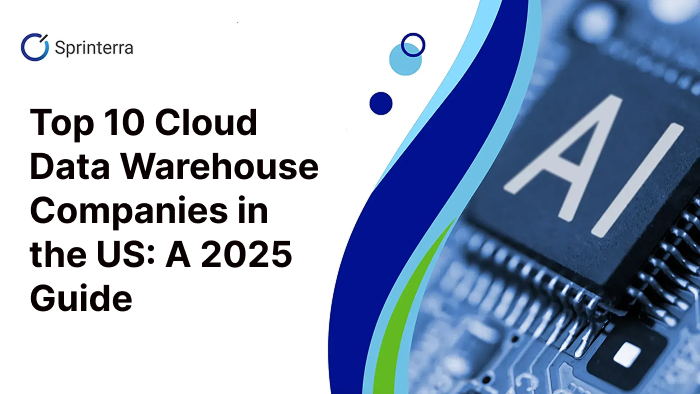
In today’s hyper-connected world, businesses are generating and collecting unprecedented volumes of data. Gathering data is no longer the main challenge. The real challenge is using it for insights, forecasting, and gaining a competitive edge. To bridge the gap between data accumulation and strategic action, organizations are turning to Cloud Data Warehouse solutions. These platforms not only store immense volumes of data but also make it searchable, structured, and ready for real-time analysis.
This blog explores the evolution of cloud data warehouses, their business benefits, and the Top 10 Cloud Data Warehouse Companies in the US leading the charge in 2025.
A data warehouse is a centralized system designed to store, organize, and analyze large volumes of structured and semi-structured data. Traditional databases handle transactions. Data warehouses, on the other hand, consolidate data from many sources for complex queries and reporting.
Advanced data warehouses can also include tools for data transformation, historical analysis, AI-driven insights, and automated data parsing, turning raw information into strategic knowledge.
s the data economy scales, the demand for more flexible, scalable, and cost-effective solutions has shifted focus from traditional on-premises servers to cloud-based data warehouses.
Benefits of Cloud-Based Warehousing:
Now, let’s dive into the top 10 cloud data warehouse providers in the US, each offering distinct capabilities to suit different business needs.
Company size: ~600 employees
Founding year: 2008
Website: https://www.acumatica.com/
Headquarters: Bellevue, Washington, USA
Overview:
Acumatica WMS is a specialized warehouse management solution designed to seamlessly integrate logistics operations with its core Cloud ERP system. Ideal for manufacturing, distribution, and retail businesses, Acumatica’s WMS facilitates real-time inventory visibility, barcode-based automation, and integration with ERP, accounting, and CRM workflows. Its strength lies in digitizing warehouse processes and extending operational data into financial and customer systems.
Though not a traditional analytics platform, the solution generates a rich source of structured operational data, timely and accurate reporting on inbound/outbound movements, stock levels, fulfillment metrics, and order cycle times. With real-time updates and automated capture, organizations gain operational transparency and traceability, enabling optimization through data-driven improvements.
Acumatica approachable pricing and cloud-native ERP architecture make it accessible to mid-market businesses that require cost-effective scalability. For enterprises seeking to bridge physical warehouse activities with backend systems, Acumatica’s WMS stands out as a practical solution to align logistics with broader business intelligence and ERM strategies.
Company size: ~7,800 employees
Founding year: July 2012
Website: https://www.snowflake.com
Headquarters: Bozeman, Montana, USA
Overview:
Snowflake is a leading cloud-native data platform known for revolutionizing data warehousing with its separation of storage and compute architecture. Established in 2012 and headquartered in Bozeman, Montana, the company supports deployment on AWS, Azure, and Google Cloud, delivering flexible, scalable analytics without infrastructure burden. With more than 9,400 customers including over 800 in the Forbes Global 2000it processes billions of daily queries across petabytes of data.
Snowflake offers instant elasticity, concurrency for thousands of users, and native support for both structured and semi-structured data types like JSON and Parquet, making it a powerful solution for ELT and real-time analytics workflows (turn0search11, turn0search0). Its data sharing features enable secure collaboration across organizational boundaries.
Snowflake’s platform also integrates with a large ecosystem of BI, data engineering, and AI tools, empowering organizations with self-service analytics capabilities. The platform’s simplicity, multi-cloud flexibility, and robust governance features make it an ideal choice for businesses that prioritize agility, scalability, and modern analytics without heavy DevOps overhead.
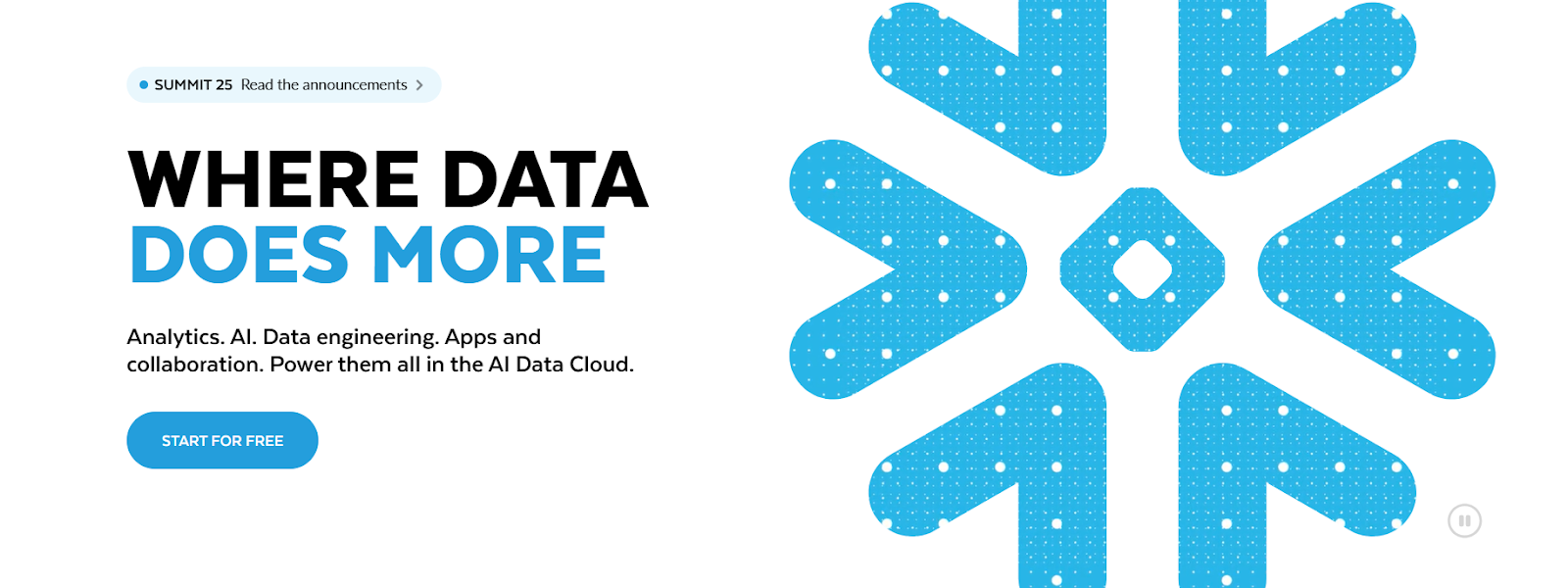
Company size: Part of Google Cloud, which employs over 50,000 globally (Google Cloud overall)
Founding year: Launched May 2010, general availability 2011–2012
Website: https://cloud.google.com/bigquery/
Headquarters: Mountain View, California, USA (Google HQ)
Overview:
Google BigQuery is a fully managed, serverless data warehouse solution from Google Cloud, ideal for large-scale analytics and machine learning use cases. Initially launched in 2010 and fully available by 2012, BigQuery builds on Google’s internal Dremel technology to offer ultra-fast query performance over petabytes of data using standard SQL (turn0search16). Its fully serverless users don’t manage infrastructure paying only for data scanned or optional flat-rate slots.
With built-in AI and ML capabilities via BigQuery ML, organizations can perform predictive analytics directly within the SQL environment. Features such as real-time streaming ingestion, automatic backup, and strong security controls make it enterprise ready. Businesses already using Google Analytics, Ads, or Looker can integrate BigQuery for streamlined data consolidation and advanced analysis. BigQuery’s flexibility for ad hoc queries, scalable performance, and cost transparency make it an excellent choice for analytics-first companies and those prioritizing rapid insight without infrastructure complexity.
Company size: ~1.5 million (part of Amazon)
Founding year: 2012
Website: https://aws.amazon.com/redshift/
Headquarters: Seattle, Washington, USA
Overview:
Amazon Redshift is a cloud-based data warehouse service that’s part of Amazon Web Services (AWS). Launched in 2012, it was among the first services to make big data analytics accessible and scalable for enterprise use. Built for petabyte-scale data workloads, Redshift excels in running complex SQL queries at lightning speed. It integrates deeply with the AWS ecosystem, including Amazon S3, Athena, Glue, and SageMaker, making it the go-to solution for organizations already operating in AWS.
Recent innovations like RA3 nodes and AQUA (Advanced Query Accelerator) bring enhanced performance and storage optimization. Redshift uses columnar storage and Massively Parallel Processing (MPP) to enable real-time analytics with high concurrency. Its flexible pricing offering both on-demand and reserved instances, makes it cost-effective for varying workload demands.
Redshift is ideal for enterprises seeking a secure, fast, and deeply integrated analytics engine that plays well with other AWS services. Whether you’re building dashboards, operational analytics, or data lakes, Amazon Redshift provides enterprise-grade solutions that scale with your business.
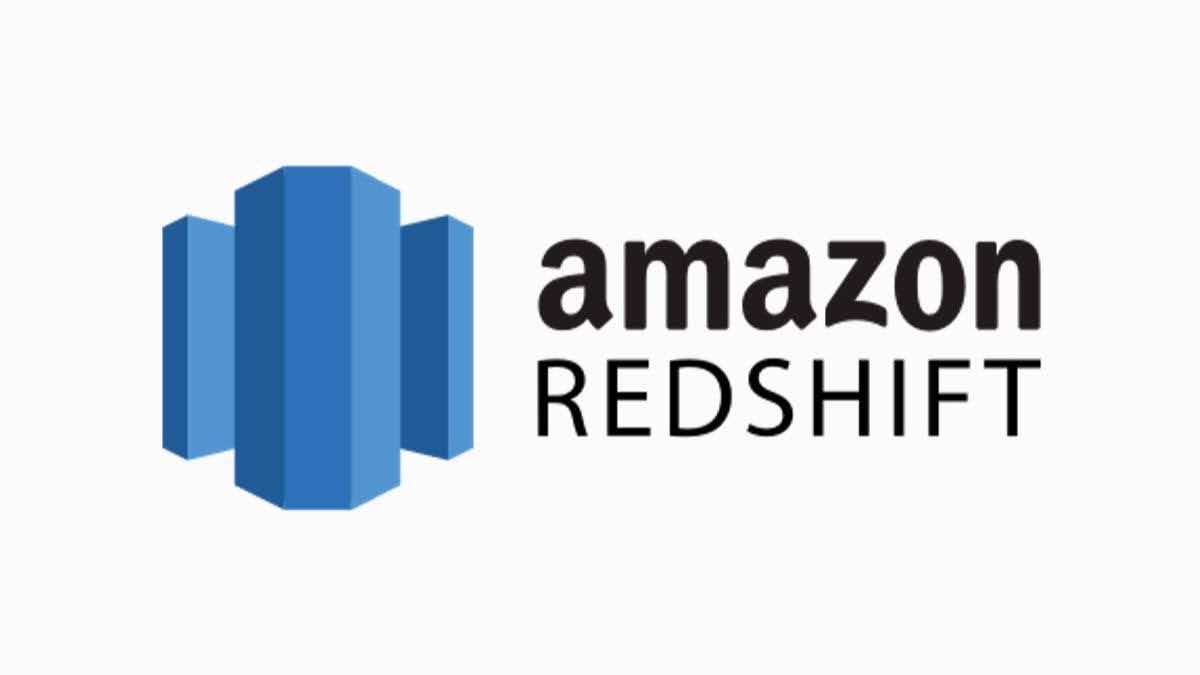
Company size: ~288,000 (part of IBM)
Founding year: 2016 (cloud offering)
Website: https://www.ibm.com/products/db2-warehouse-on-cloud
Headquarters: Armonk, New York, USA
Overview:
IBM Db2 Warehouse on Cloud is a fully managed, enterprise-class cloud data warehouse designed for high-performance analytics and transactional workloads. Built on IBM’s Netezza and Db2 technologies, it brings fast, in-memory processing and robust data governance capabilities to cloud environments.
This platform is optimized for hybrid and multi-cloud deployments and integrates well with SAP, Oracle, and IBM’s AI-driven Watson services. It offers advanced database analytics, geospatial analytics, and native support for popular BI tools. With built-in encryption, role-based access controls, and regulatory compliance features, it’s particularly well-suited for industries with stringent security requirements.
Ideal for large enterprises, Db2 Warehouse on Cloud provides scalability, resilience, and the familiarity of IBM’s legacy systems with the agility of the cloud. Its support for both structured and unstructured data, along with machine learning and predictive analytics capabilities, makes it a powerful tool for modern data science and business intelligence applications.
Company size: ~200–500 employees
Founding year: 2019
Website: https://www.firebolt.io
Headquarters: New York, New York, USA
Overview:
Firebolt is a next-generation cloud data warehouse built for ultra-fast analytics and real-time performance at scale. Founded in 2019, Firebolt offers a unique approach to cloud warehousing by decoupling storage and compute, allowing users to scale independently and efficiently. It’s particularly well-suited for developers and data teams who prioritize low-latency query performance.
The platform supports advanced indexing, vectorized query execution, and high compression rates, making it ideal for SaaS applications, customer-facing dashboards, and analytics on large-scale semi-structured data. Firebolt also supports SQL-based transformations and integrates with modern data ecosystems, including debt and Kafka.
Businesses that rely on rapid decision-making, real-time metrics, and user-facing analytics benefit from Firebolts speed and agility. Its modern architecture makes it an excellent alternative to legacy data warehouses for digital-native companies and tech-driven enterprises.
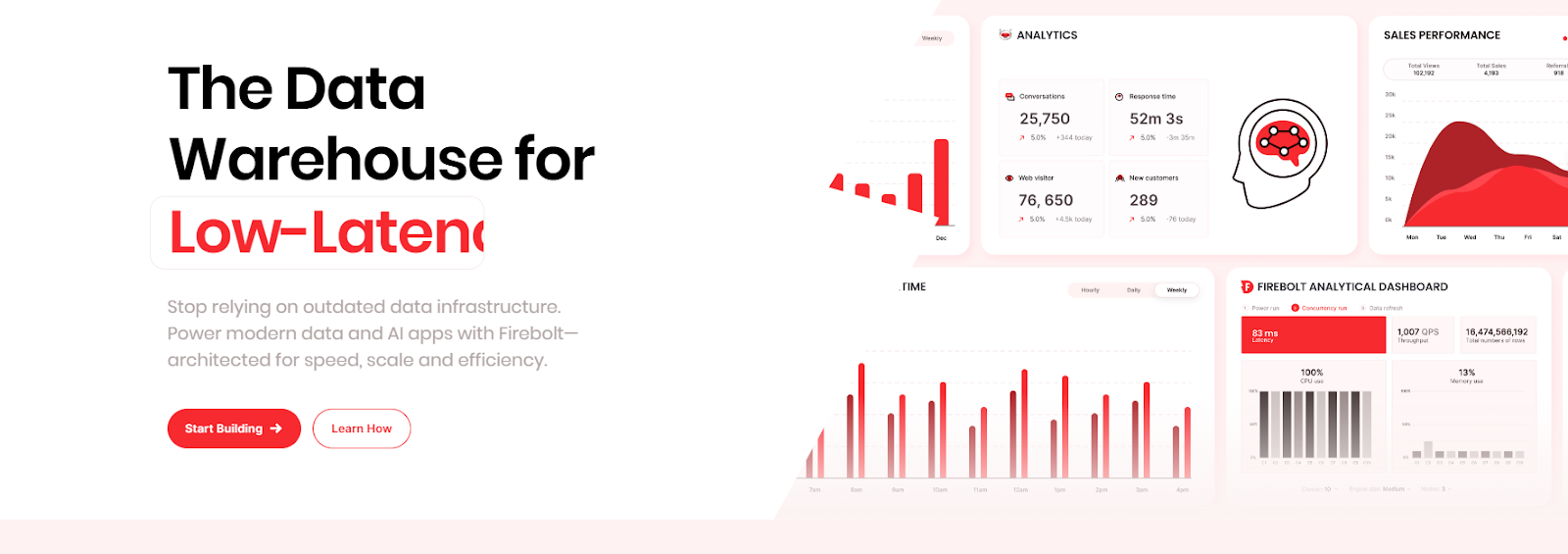
Company size: ~100–200 employees
Founding year: 2016 (open-source); ClickHouse Inc. founded in 2021
Website: https://clickhouse.com
Headquarters: San Jose, California, USA
Overview:
ClickHouse Cloud is the managed service version of the popular open-source ClickHouse database, designed for real-time, high-speed analytics on massive datasets. Its columnar storage architecture allows lightning-fast read performance, making it ideal for dashboards, log analysis, and operational monitoring.
ClickHouse scales horizontally, easily handling billions of rows and terabytes of data with sub-second query performance. It is widely adopted in high-throughput environments such as financial services, digital marketing, gaming, and eCommerce. The cloud offering adds managed infrastructure, auto scaling, and simple setup, reducing the complexity of running ClickHouse in production.
As a developer-focused platform, Click House offers an intuitive SQL interface, support for integrations like Grafana and Kafka, and access to an active open-source community. Businesses seeking a powerful and flexible analytics engine with minimal latency will find ClickHouse Cloud to be an ideal fit.
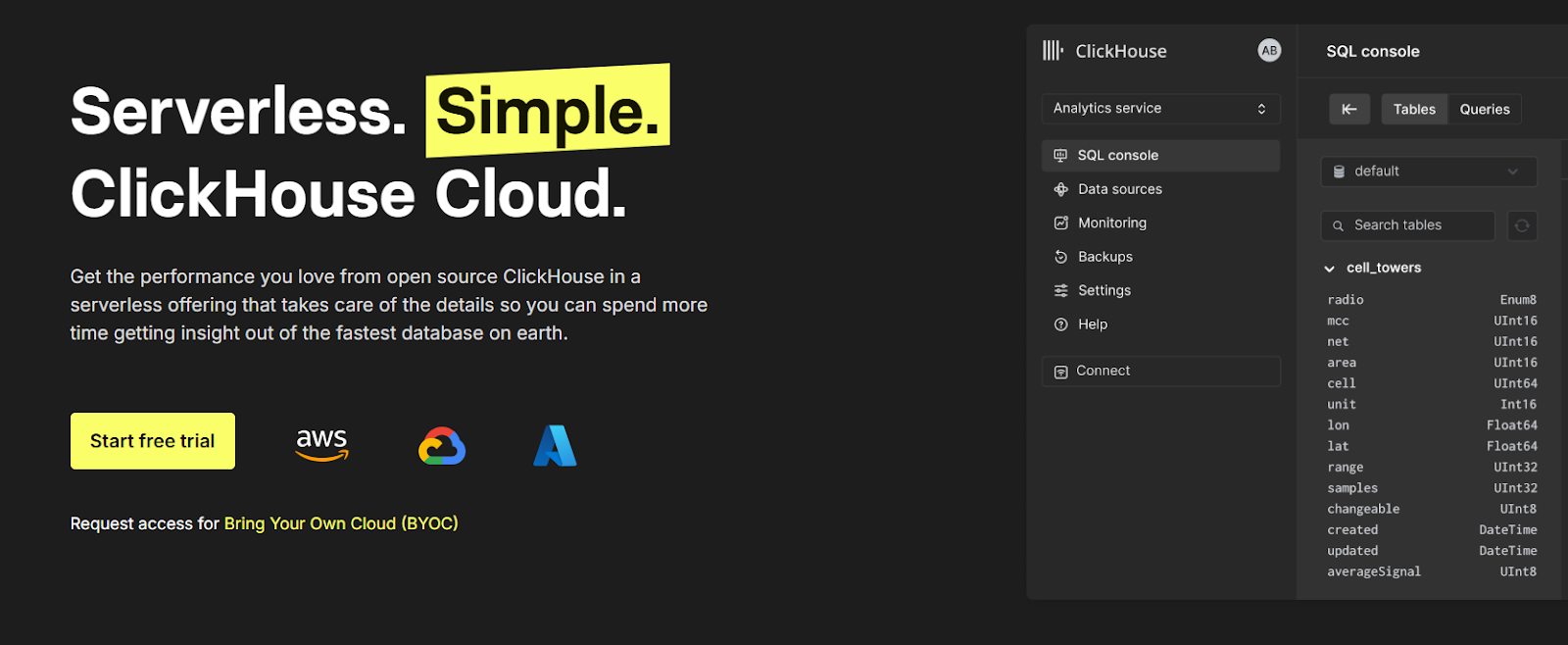
Company size: ~6,000 employees
Founding year: 2013
Website: https://www.databricks.com
Headquarters: San Francisco, California, USA
Overview:
Databricks pioneered the concept of the “Lakehouse” architecture, which combines the best elements of data lakes and data warehouses into a unified platform. Built on Apache Spark and optimized for AI and machine learning workloads, Databricks provides collaborative notebooks, robust data engineering pipelines, and scalable analytics all on a single platform.
The Lakehouse architecture supports structured, semi-structured, and unstructured data and leverages Delta Lake to ensure data reliability, consistency, and ACID compliance. Teams can collaboratively develop, analyze, and visualize data using built-in tools and popular programming languages like Python, SQL, and Scala.
Databricks is a preferred choice for organizations focused on AI, big data analytics, and end-to-end data workflows. It enables seamless integration with tools like MLflow, Azure, and AWS, making it a highly adaptable platform. For businesses merging analytics, data science, and machine learning, Databricks delivers performance, scalability, and ease of use.
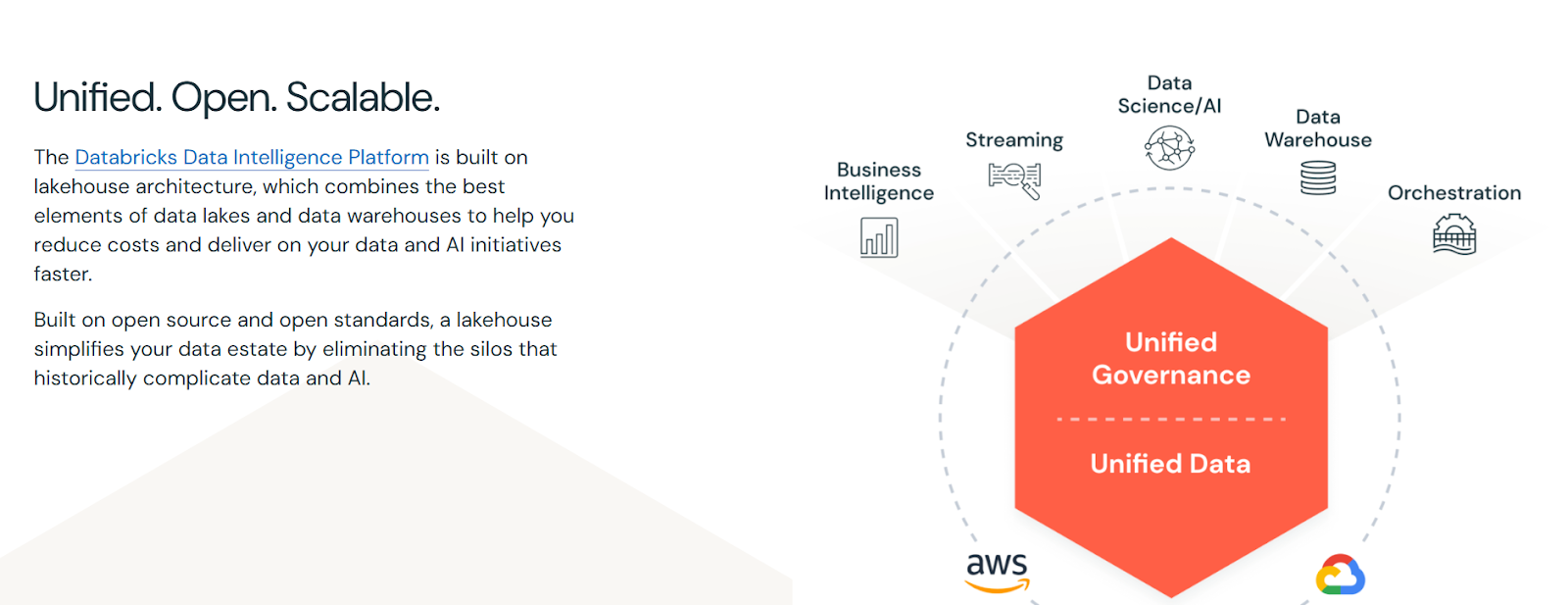
Company size: ~140,000 employees
Founding year: 2018 (Autonomous DW); Oracle founded in 1977
Website: https://www.oracle.com/autonomous-database
Headquarters: Austin, Texas, USA
Overview:
Oracle Autonomous Data Warehouse (ADW) is a fully managed, AI-powered cloud solution that eliminates the need for manual database administration. Leveraging machine learning and AI, the platform handles patching, tuning, backups, and security automatically, allowing businesses to focus solely on extracting value from their data.
ADW offers native integration with Oracle Cloud Infrastructure (OCI), along with multi-model data support including relational, JSON, and XML formats. It also includes strong data security features like always-on encryption and activity auditing. Built-in scalability and high performance make it a solid option for mission-critical enterprise workloads.
Ideal for businesses already invested in Oracle’s ecosystem, ADW provides a seamless transition to the cloud with all the reliability and governance enterprises expect from Oracle. It’s especially suited for organizations seeking a hands-off, secure, and efficient data warehousing solution without the traditional administrative complexity.
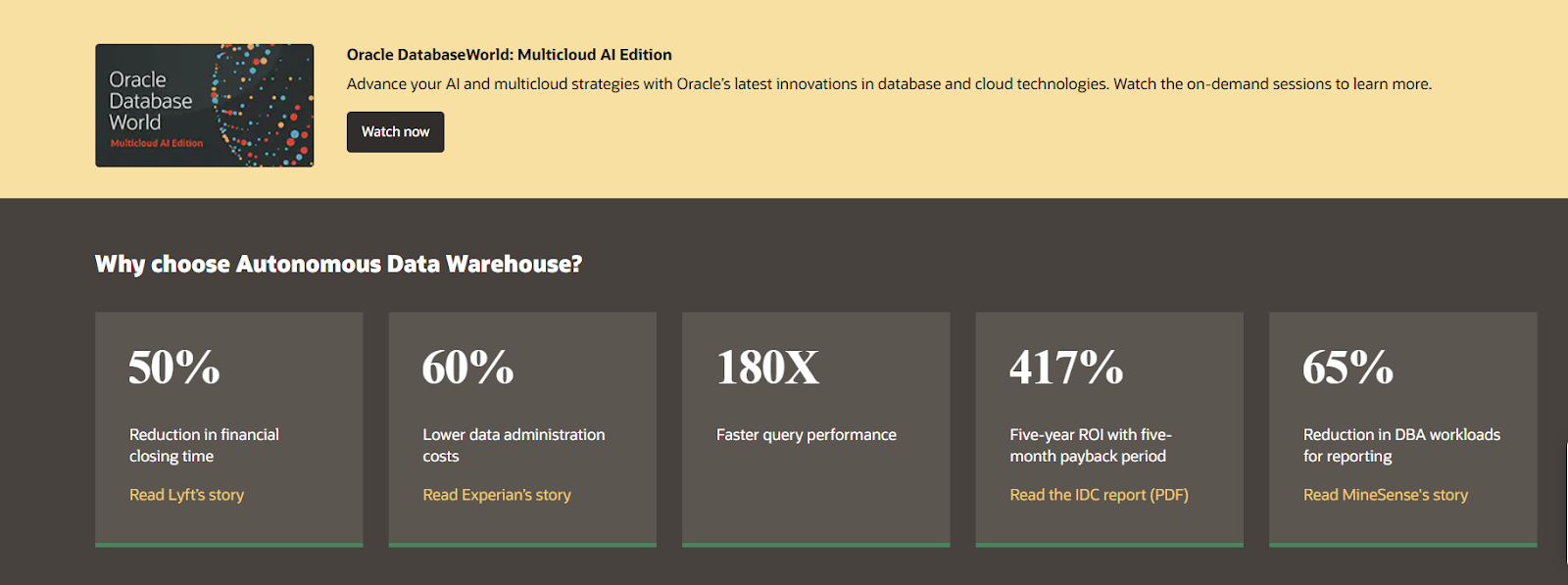
The future of business is data-driven, and cloud data warehouses are at the center of this transformation. The right platform empowers your teams to:
Want to simplify how your cloud data warehouse connects with your ecosystem? Sprinterra enables seamless ELT pipelines, reverse-ELT, and real-time reporting integrations to modernize your entire data stack.
Cloud data warehouses are not just storage tools, they’re strategic platforms that enable speed, scalability, and innovation. Whether you’re a startup managing gigabytes or an enterprise handling petabytes, the providers listed here can help you unlock the full potential of your data.
Ready to revolutionize your data infrastructure?
Explore the above platforms, compare features, and choose the best fit for your data strategy in 2025 and beyond.
A cloud data warehouse is an online platform that stores and manages large volumes of data for analysis. Unlike traditional on-premise systems, it offers scalability, cost efficiency, and accessibility through cloud infrastructure.
Cloud data warehouses provide flexible storage, fast query performance, and easy integration with analytics tools. They eliminate the need for expensive hardware and allow teams to access data from anywhere.
Important features include scalability, real-time analytics, security controls, integration with BI tools, multi-cloud support, and automated maintenance like backups and tuning.
Industries such as finance, retail, healthcare, eCommerce, and manufacturing benefit the most due to their need for large-scale analytics, customer insights, compliance, and operational reporting.
Consider your business size, data volume, preferred cloud ecosystem, analytics needs, and budget. Choose a provider that aligns with your scalability, performance, and compliance requirements.
Get the latest insights on exponential technologies delivered straight to you